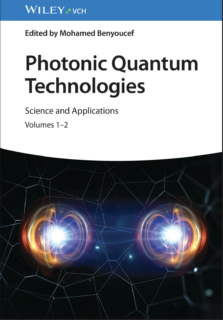Book chapter „Collective Light Emission of Ion Crystals in Correlated Dicke States“ published
In the recently published book Photonic Quantum Technologies: Science and Applications, a team of distinguished scientists from different disciplines deliver an authoritative, one-stop overview of up-to-date research on various quantum systems.
Ferdinand Schmidt-Kaler (JGU Mainz collaborator) and Joachim von Zanthier (QOQI group) contributed a chapter on Collective Light Emission of Ion Crystals in Correlated Dicke States, in which an overview of collective light scattering of trapped ion crystals serving as arrays of correlated emitters of single, indistinguishable photons is given.
Summary of the chapter
We give an overview of collective light scattering of trapped ion crystals serving as arrays of correlated emitters of single, indistinguishable photons into free space. The collectively emitted light is recorded in the far field by detectors, which feature high spatial and high temporal resolution. We observe interference in the first- and second-order photon correlation functions as well as bunched and antibunched photon statistics. We analyze theoretically how the observed features of collective light scattering off arrays of correlated single photon emitters result from projective quantum measurements into Dicke states.
Abstract of the book
This unique book reviews the state-of-the-art research in photonic quantum technologies and bridges the fundamentals of the field with applications to provide readers from academia and industry, in one-location resource, with cutting-edge knowledge they need to have to understand and develop practical quantum systems for application in e.g., secure quantum communication, quantum metrology, and quantum computing. The book also addresses fundamental and engineering challenges en route to workable quantum devices and ways to circumvent or overcome them.
Readers will also find:
- A thorough introduction to the fundamentals of quantum technologies, including discussions of the second quantum revolution (by Nobel Laureate Alain Aspect), solid-state quantum optics, and non-classical light and quantum entanglement
- Comprehensive explorations of emerging quantum technologies and their practical applications, including quantum repeaters, satellite-based quantum communication, quantum networks, silicon quantum photonics, integrated quantum systems, and future vision
- Practical discussions of quantum technologies with artificial atoms, color centers, 2D materials, molecules, atoms, ions, and optical clocks
Perfect for molecular and solid-state physicists, Photonic Quantum Technologies: Science and Applications will also benefit industrial and academic researchers in photonics and quantum optics, graduate students in the field; engineers, chemists, and computer and material scientists.
